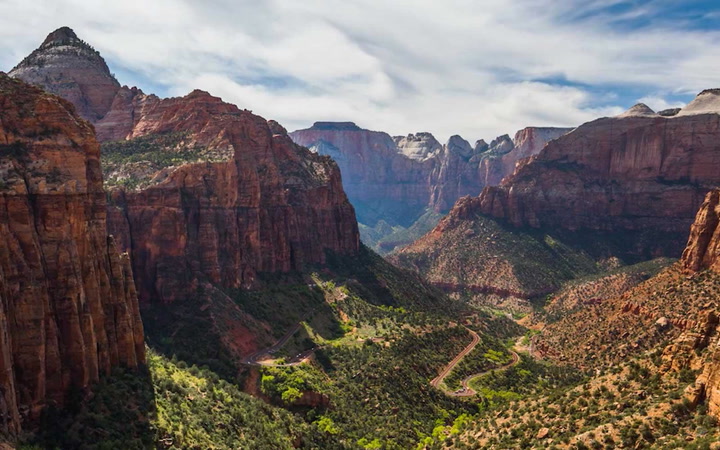1. Overview of Zion National Park
2. Getting to and Around the Park
3. Camping and Lodging Options
4. Hiking Trails
5. Additional Activities
6. Weather Considerations
Zion National Park, one of Utah’s “Mighty Five” national parks, is among the most visited parks in the U.S. With its stunning views, world-class hiking, and unique narrow slot canyons, it’s no surprise that people return to Zion year after year. Here’s how to plan an unforgettable adventure in one of America’s most cherished national parks.
Getting to and Around Zion National Park
To reach Zion National Park, visitors can fly into Las Vegas, Nevada, located 170 miles from the park, or into Salt Lake City, Utah, approximately 300 miles away. Alternatively, Saint George Regional Airport, just 49 miles away, offers connecting flights from Salt Lake City and Denver, Colorado.
During most of the year, the park provides two free shuttle services: one travels along the Zion Canyon Line between the Zion Canyon Visitor Center and the Temple of Sinawava, while the other connects Zion Canyon Village to the Majestic View Lodge. Hikers often utilize this shuttle system to take advantage of one-way routes, with strollers and non-electric bikes permitted.
Camping and Lodging Options in Zion National Park
Travelers looking to stay at Zion have two primary options: camping and hotels. The park features three campgrounds. Watchman Campground operates year-round and requires reservations, while Lava Point Campground, which is closed in winter, also recommends making reservations. South Campground is currently undergoing a long-term rehabilitation project and is not available. Campground reservations can be made on Recreation.gov or by calling 877-444-6777.
If you’re seeking a blend of camping enjoyment with a touch of luxury, Under Canvas Zion offers upscale glamping tents complete with king beds and full bathrooms on 196 picturesque acres bordering the park. Guests can engage in various activities such as canyoneering, stargazing tours, mountain biking, and rock climbing.
For those preferring traditional accommodations, Zion Lodge, the sole in-park lodge, offers the convenience of a cozy room after a day of trekking, along with on-site dining and horseback riding excursions. If Zion Lodge is unavailable, Spirit, a new luxury resort set to fully open in 2023, features spacious suites with stunning landscape views. SpringHill Suites, a Marriott hotel located just outside the park, provides guests with exquisite rooms, dining options, and an outdoor swimming pool boasting incredible views.
Exciting Hiking Trails in Zion National Park
Zion National Park boasts countless hiking trails ranging in difficulty. Although there is a paved trail suitable for wheelchair users, some of the park’s renowned hikes may be too challenging for certain skill levels and can be closed due to unsafe conditions.
Pa’rus Trail
This accessible 3.5-mile round-trip trail follows a paved path along the Virgin River, extending from the South Campground to Canyon Junction. Both bikes and leashed pets are welcome on this trail, which can be accessed from the Visitor Center.
Angels Landing
As Zion National Park’s most famous trail, Angels Landing requires visitors to apply for a permit before attempting the 5.4-mile round-trip trek. While the vistas are breathtaking, the route presents challenges and its steep drop-offs make it unsuitable for children or anyone afraid of heights. Hiking is possible in winter for those experienced in snowy conditions, but traction devices are highly recommended.
The Narrows
This iconic slot canyon trail travels upstream through a gorge—surrounded by thousand-foot high walls on either side. As you wade through the Virgin River, it’s advisable to wear close-toed shoes and use walking poles, as the rocks can be slippery. The best time to hike this trail is during summer and early fall; however, always check in at the Visitor Center for the latest weather updates as flash flood risks may prompt park authorities to close the trail.
Other Activities in Zion National Park
In addition to hiking, Zion’s remarkable geology provides opportunities for adventure, such as canyoneering (which requires a permit) and rock climbing, best done from March to May or September to early November when the weather is favorable. Bicycles are only permitted on the paved Pa’rus Trail and specified roadways, including the Zion Canyon Scenic Drive. For a unique experience, horseback riding tours are offered by Canyon Rides along the Sandbench Trail. Experienced kayakers may consider bringing paddles to enjoy the Virgin River, but a permit secured in advance is necessary.
Weather Considerations for Zion National Park
The weather in Zion National Park varies throughout the year. In summer, temperatures may soar above 100 degrees, while winter highs typically hover between 50 and 60 degrees Fahrenheit and snowfall can occur. The spring and fall months are often ideal for visiting due to more moderate temperatures that seldom exceed 90 degrees Fahrenheit.
The best time to visit depends on personal preferences. Given its increasing popularity, avoiding peak crowd periods from April to September may be wise—approximately 70% of all visitors come during this timeframe, particularly in July. Alternatively, January tends to be the least crowded month, offering the chance for a pleasantly mild day in the mid-50s. However, if hiking the Narrows is a goal, summer to early fall is the prime season, with spring often seeing trail closures due to snowmelt and rising waters.





